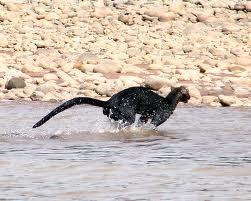Let me put it this way... I have seen Florida panthers (Puma concolor=same as cougar, mountain lion, puma, etc.) and gray fox, both in the wild and in captivity, and I have lived with house cats (among many other species) my entire life. My wife and I are active in animal rescue, including domestic (dog, cat, farm, etc.), exotic (feral/escaped/released nonnatives), and wildlife. My initial reaction to the gamecam photos was "what kind of cat is that?" Panther and fox never occurred to me because my experiences of actual encounters with these animals, does not allow me to be deceived by something, that to me, is clearly not one of these two animals. Typically, when one is familiar with an animal's appearance, habits, behavior, etc., the familiar animal is instantly recognized. That's why I'm convinced that it's a feline. That's what "jumps out" to me. That also seems to be the initial response of most people posting here. After all, everyone on team big cat thinks it's feline, and a number of people on team fox admit that they were initially on team big cat, meaning their instinct said "cat." Add to that, the extensive posts on here by team fox, who have reinforced my gut feelings by thoroughly debunking team big cat, and the extensive post by team big cat, who have likewise reinforced my initial instincts, by thoroughly debunking team fox... both camps have left me more convinced than ever that we are dealing with a cat.
The best arguments presented for this being a fox, require us to embrace that this is a gray fox with mange. This is highly unlikely, as the gray fox is resistant to mange. In addition, my experience with animals with mange, is that they don't loose their hair uniformly on the entire body, but instead loose it in random patches. Also, where hair loss does occur on mangy animals, it's usually lost all the way to the skin, not appearing as if it were trimmed to a uniformed length. In short, that's the healthiest looking mangy fox in the world. It has also been suggested that the "fox" might be shedding, and that's why his tail and coat are thiner than all the other gray fox on every available google image of grey fox. The main problem with that argument, is that we are at exactly the opposite time of year for shedding to occur in the northern hemisphere. Autumn is the time to put on weight and grow a thicker coat in preparation for winter, not the time to shed.
Another issue I have with team fox is the fact that the gray fox territory is usually less than a square mile. Also, dispersal distances of young gray fox are short. Most young grays relocate and select new home ranges within a mile of their birthplace. For that reason, high densities of gray fox can sometimes be found in suitable habitats. Taking this into consideration, this camera should have picked up several more photos, on subsequent days, of this animal, or others of its species, if in fact it were a gray fox.
I sent a link to this discussion to a woman at a big cat rescue, here in Florida, and this is her response:
"Looks like a domestic cat to me because of the tabby stripes, long tail and size. It appears to be a male, marking territory via spraying."
Now, as someone who is extremely familiar with big cats, including Puma concolor, she would know one when she sees one, and in these photos, she didn't see one. On the other hand, she knows a feline when she sees one, and she did see one in the photos. If she were looking at something she was less familiar with, (say... a gray fox?) she might have said something like "not sure what it is, but it doesn't look like a cat to me." It looked enough like a cat, to a cat expert, for her to say "looks like a domestic cat." Now when I saw the "tabby stripes," I thought it was the ribs of a thin cat, but after reading her response, I took a closer look and noticed that the end of the tail, in photo #2, clearly has bands, or "tabby stripes." The motion of the animal in the other photos makes the stripes blur, causing the appearance of a dark tipped tail, but a closer look at the tail in photo #2 confirms that we are not only dealing with a cat, but it appears to be a tabby... arguably, the most common of all house cats.





